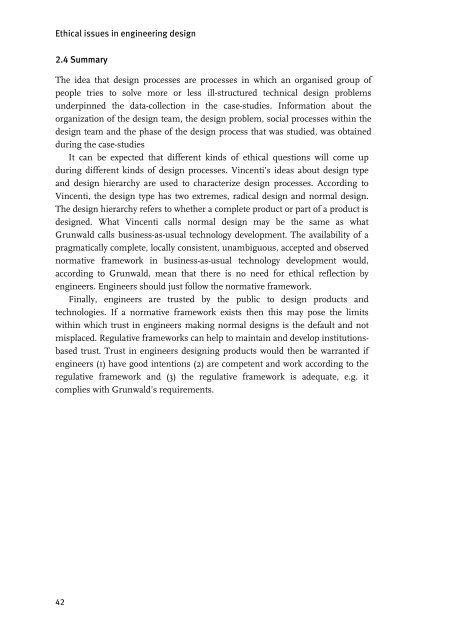Ethical issues in engineering design - 3TU.Centre for Ethics and ...
Ethical issues in engineering design - 3TU.Centre for Ethics and ...
Ethical issues in engineering design - 3TU.Centre for Ethics and ...
Create successful ePaper yourself
Turn your PDF publications into a flip-book with our unique Google optimized e-Paper software.
<strong>Ethical</strong> <strong>issues</strong> <strong>in</strong> eng<strong>in</strong>eer<strong>in</strong>g <strong>design</strong><br />
2.4 Summary<br />
The idea that <strong>design</strong> processes are processes <strong>in</strong> which an organised group of<br />
people tries to solve more or less ill-structured technical <strong>design</strong> problems<br />
underp<strong>in</strong>ned the data-collection <strong>in</strong> the case-studies. In<strong>for</strong>mation about the<br />
organization of the <strong>design</strong> team, the <strong>design</strong> problem, social processes with<strong>in</strong> the<br />
<strong>design</strong> team <strong>and</strong> the phase of the <strong>design</strong> process that was studied, was obta<strong>in</strong>ed<br />
dur<strong>in</strong>g the case-studies<br />
It can be expected that different k<strong>in</strong>ds of ethical questions will come up<br />
dur<strong>in</strong>g different k<strong>in</strong>ds of <strong>design</strong> processes. V<strong>in</strong>centi’s ideas about <strong>design</strong> type<br />
<strong>and</strong> <strong>design</strong> hierarchy are used to characterize <strong>design</strong> processes. Accord<strong>in</strong>g to<br />
V<strong>in</strong>centi, the <strong>design</strong> type has two extremes, radical <strong>design</strong> <strong>and</strong> normal <strong>design</strong>.<br />
The <strong>design</strong> hierarchy refers to whether a complete product or part of a product is<br />
<strong>design</strong>ed. What V<strong>in</strong>centi calls normal <strong>design</strong> may be the same as what<br />
Grunwald calls bus<strong>in</strong>ess-as-usual technology development. The availability of a<br />
pragmatically complete, locally consistent, unambiguous, accepted <strong>and</strong> observed<br />
normative framework <strong>in</strong> bus<strong>in</strong>ess-as-usual technology development would,<br />
accord<strong>in</strong>g to Grunwald, mean that there is no need <strong>for</strong> ethical reflection by<br />
eng<strong>in</strong>eers. Eng<strong>in</strong>eers should just follow the normative framework.<br />
F<strong>in</strong>ally, eng<strong>in</strong>eers are trusted by the public to <strong>design</strong> products <strong>and</strong><br />
technologies. If a normative framework exists then this may pose the limits<br />
with<strong>in</strong> which trust <strong>in</strong> eng<strong>in</strong>eers mak<strong>in</strong>g normal <strong>design</strong>s is the default <strong>and</strong> not<br />
misplaced. Regulative frameworks can help to ma<strong>in</strong>ta<strong>in</strong> <strong>and</strong> develop <strong>in</strong>stitutionsbased<br />
trust. Trust <strong>in</strong> eng<strong>in</strong>eers <strong>design</strong><strong>in</strong>g products would then be warranted if<br />
eng<strong>in</strong>eers (1) have good <strong>in</strong>tentions (2) are competent <strong>and</strong> work accord<strong>in</strong>g to the<br />
regulative framework <strong>and</strong> (3) the regulative framework is adequate, e.g. it<br />
complies with Grunwald’s requirements.<br />
42



